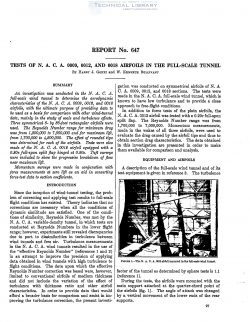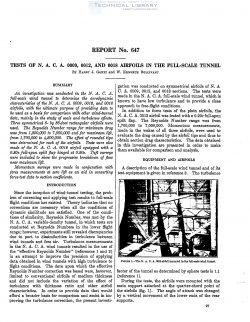naca-report-647

- Version
- 450 Downloads
- 861.85 KB File Size
- 1 File Count
- August 30, 2016 Create Date
- August 30, 2016 Last Updated
National Advisory Committee for Aeronautics, Report - Tests of NACA 0009, 0012, and 0018 Airfoils in the Full Scale Tunnel

Since the inception of Wind-tunnel testing, the prob-
lem of correcting and applying test results to full-scale
flight conditions has existed. Theory indicates that no
corrections are necessary when all the conditions of
dynamic similitude are satisfied. One of the condi-
tions of similarity, Reynolds Number, was met by the
N. A. C. A. variable-density tunnel, in which tests are
conducted at Reynolds Numbers in the lower flight
range; however, experiments still revealed discrepancies
due in part to dissimilarities in turbulence between
wind tuunels and free air. Turbulence measurements
in the N. A. C. A. wind tunnels resulted in the use of
the “efiective Reynolds Number” (references 1 and 2)
in an attempt to improve the precision of applying
data obtained in wind tunnels with high turbulence to
flight conditions. The data upon which the effective
Reynolds Number correction was based were, however,
limited to conventional airfoils of medium thickness
and did not include the variation of the effect of
turbulence with thickness ratio and other lairfoil
characteristics. In order to provide data that would
afford a broader basis for comparison and assist in im-
proving the turbulence correction, the present investi-
gation was conducted on symmetrical airfoils of N. A
C. A. 0009, 0012, and 0018 sections. The tests were
made in the N. A. C. A. full-scale wind tunnel, which is
known to have low turbulence and to provide a- close
approach to free-flight conditions.
In addition to force tests of the plain airfoils, the
N. A. C. A. 0012 airfoil was tested with a 0.20c full-span
split flap. The Reynolds Number range was from
1,700,000 to 7,000,000. Momentum measurements,
made in the wakes of all three airfoils, were used to
evaluate the drag caused by the airfoil tips and thus to
obtain section drag characteristics. The data obtained
in this investigation are presented in order to make
them available for comparison and analysis.
| File | Action |
|---|---|
| naca-report-647 Tests of NACA 0009, 0012, and 0018 Airfoils in the Full Scale Tunnel.pdf | Download |
Comment On This Post